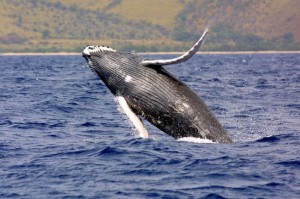
The National Oceanic and Atmospheric Administration is asking for public comment on guidelines updating the effects of human-made sounds on marine mammals.
Marine mammals rely on their sense of sound for survival. “They use it for feeding, locating mates, and just generally understanding what’s going on in the world around them,” says NOAA fisheries biologist Amy Scholik-Schlomer, who is also an acoustic specialist.
She says the guidelines update the levels at which human-made sounds affect marine mammals temporarily and permanently. NOAA calls these threshold shifts. A marine mammal experiencing a temporary threshold shift is like going to a rock concert. “Your hearing is temporarily affected but it fully recovers, while permanent threshold shift would be something that your hearing is affected but it doesn’t fully recover. You have some permanent loss. It doesn’t mean you’re deaf and it doesn’t mean that it affects your entire hearing range; it just means that you can’t hear quite as well as you could before,” Scholik-Schlomer explains.
Brad Smith is a marine mammal biologist with NOAA in Anchorage. He says acoustic impacts on marine mammals are pertinent to Alaska, especially to the oil and gas industry, “We have seismic geophysical surveys which introduce very, very loud sounds into the water in areas where we have endangered and threatened species and marine mammals in general, notably the Chukchi and Beaufort Seas and, more recently, in Cook Inlet.”
The construction industry also needs to be aware of the sounds it creates.
“The Port of Anchorage, certainly the KABATA crossing, the bridge if its built, all those construction activities that involve pile driving or placing sheet pile, possibly others such as dredging, anything that creates in-water noise in areas where marine mammals exist may potentially generate enough noise to cause an animal to be harassed,” Smith says.
Activities involving operating a vessel, like running a loud outboard motor, don’t reach the same levels of in-water noise, he says.
Scholik-Schlomer says the new guidelines address the fact that different marine mammals hear noise differently. For example, humpback whales are considered low frequency cetaceans. Many human-made sounds heard underwater that come from construction activities or seismic surveys are also low frequency. “Humpback whales hear and use low frequency sounds so they would be more impacted by something like seismic, opposed to killer whales who actually hear better at higher frequencies where there isn’t as much anthropogenic sounds,” she says.
How sounds affect marine marines is still an emerging science and Scholik-Schlomer says there are gaps in research:
“All the large whale species, we actually have no direct information on how they hear because it’s difficult to do those types of studies, so we have to use the best available information we have and extrapolate from data from bottlenose dolphins or even sometimes from terrestrial species, like mice and rats, where we don’t have any other data.”
The public comment period on the updated acoustic guidelines ends Jan. 27. Due to requests from members of Alaska’s congressional delegation, the oil industry, and various conservation organizations, NOAA is considering an extension to the public comment period.
Lisa Phu is a reporter at KTOO in Juneau.




